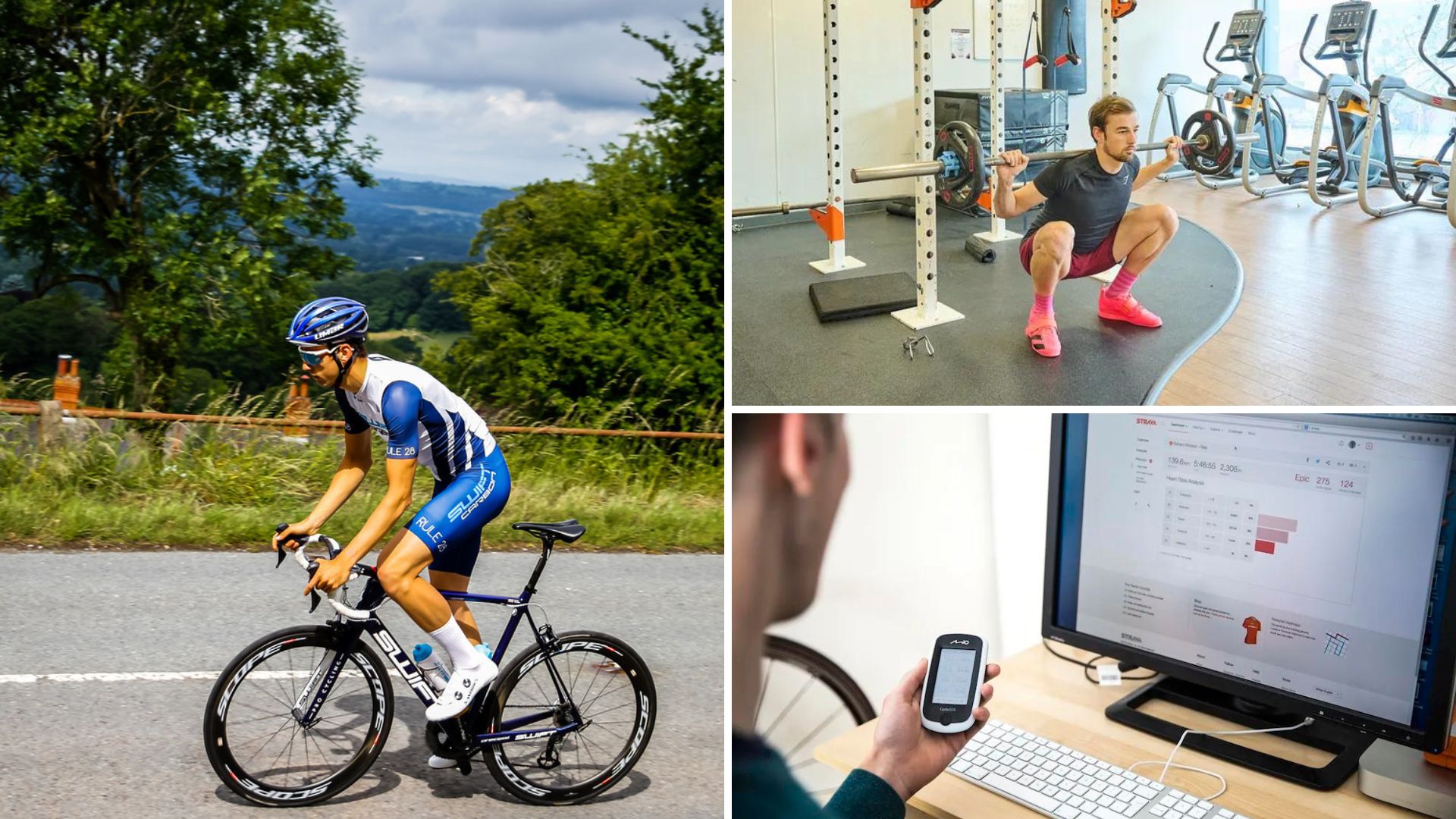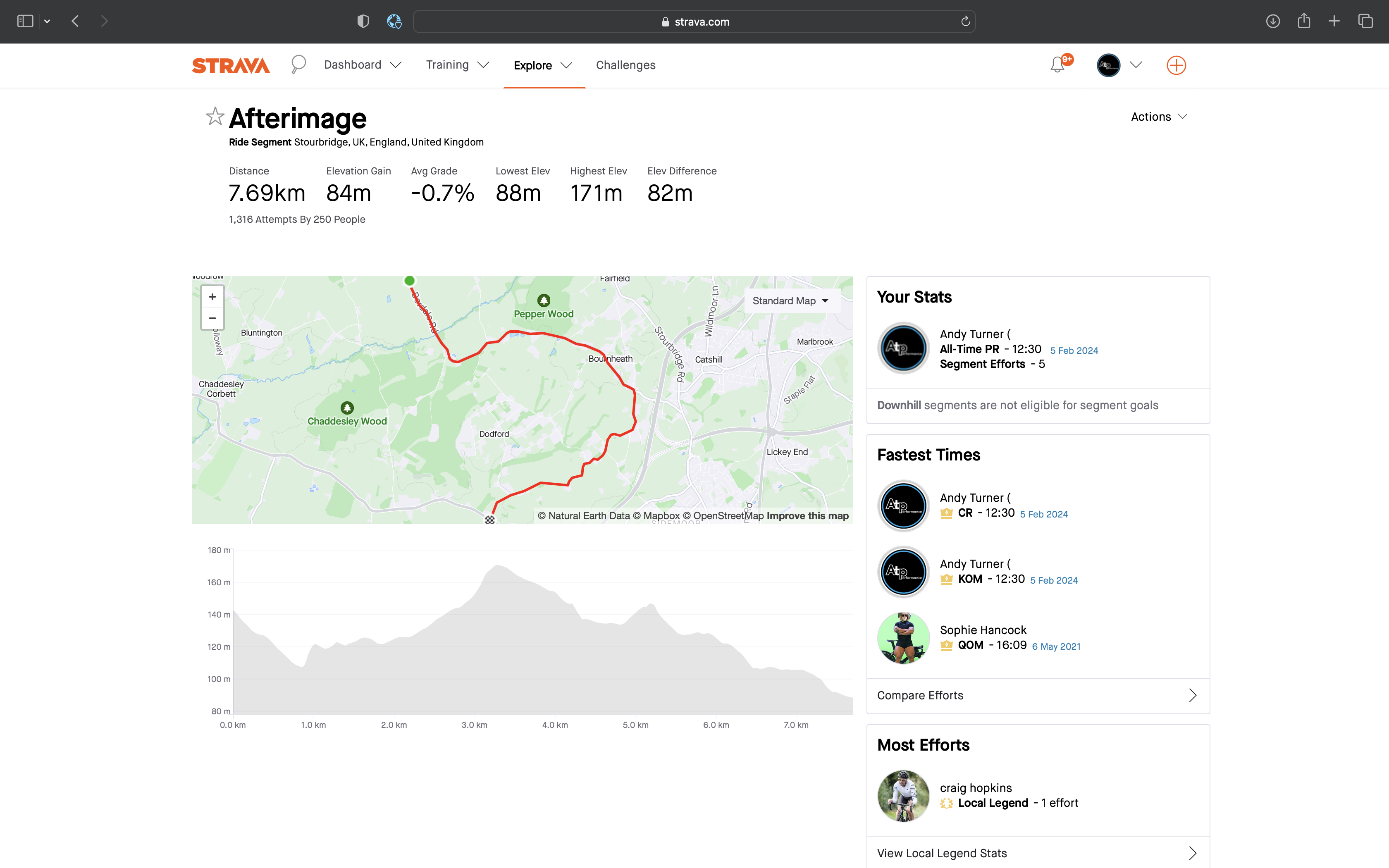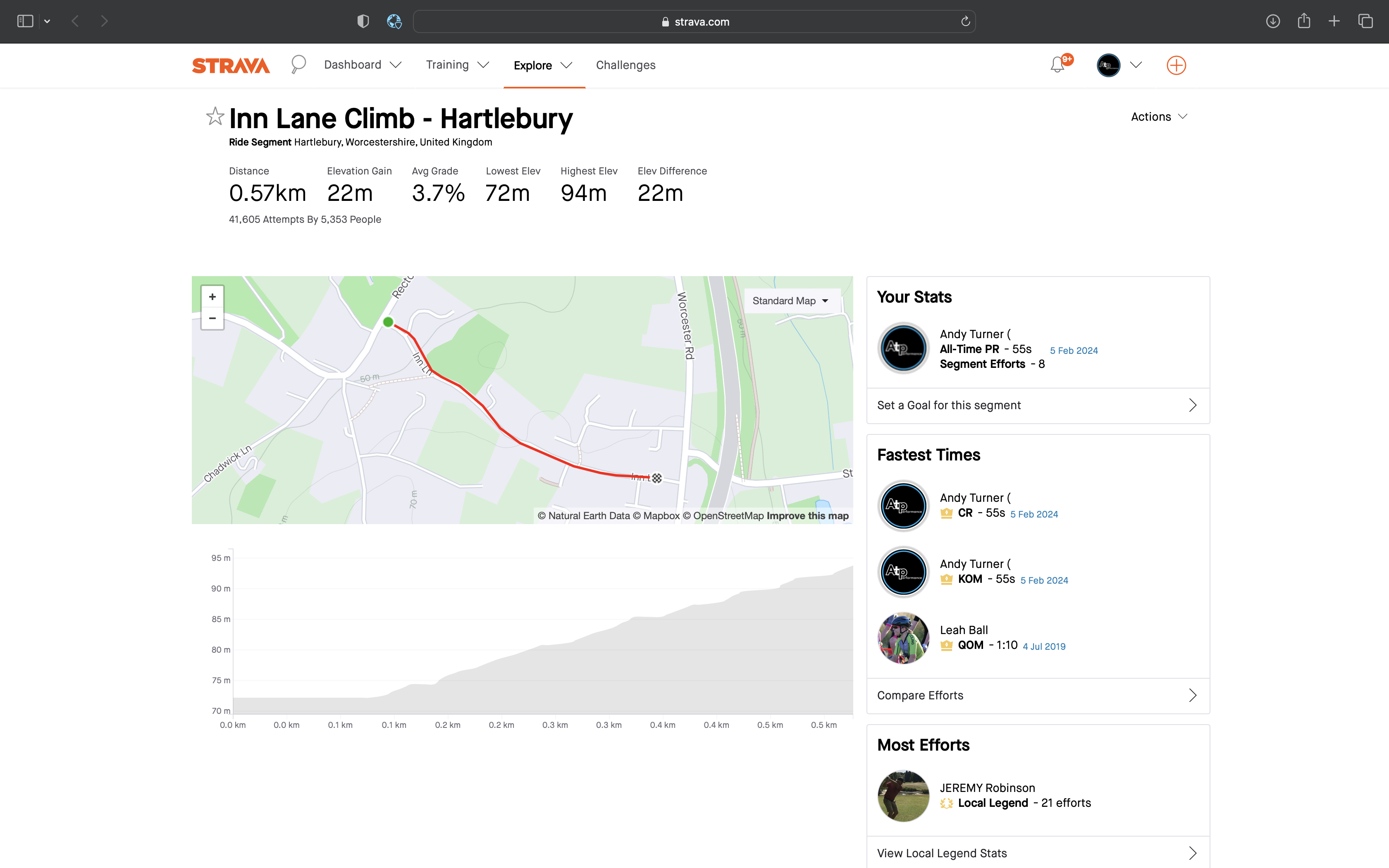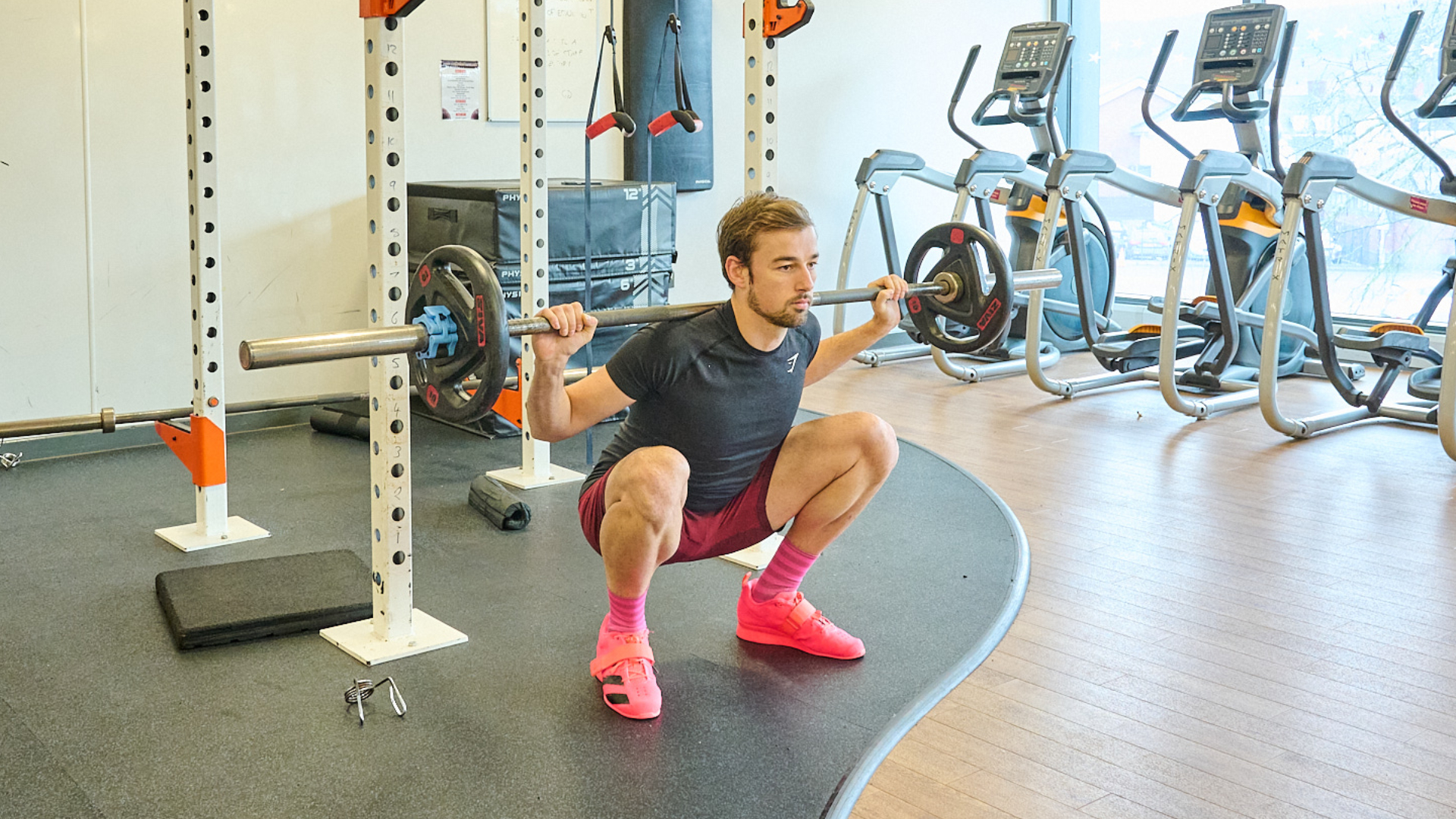
Strava has over 100 million users, so it may not come as a surprise that gaining a King of the Mountain (KOM) or Queen of the Mountain (QOM) crown - by clocking the fastest time over the segment ever - is harder than it used to be, when the cycling social media platform first launched in 2009.
Gaining a KOM has certainly become harder for me, of late. Having previously ridden for a UCI team, I've not raced my bike or trained consistently since 2021. I've seen my power output across all levels drop quite significantly. In my past life, I was training 15-20 hours a week. Now, thanks to Long Covid, work, and a multitude of other factors, my average training time sits at around three to four hours a week (including off the bike work), if I'm lucky. January was a more consistent month though, with seven hours a week for training, setting me up nicely for some segment hunting.
I wanted to see if, taking a 'no stone left unturned' approach, I could gain a crown again.
The segments
I chose two local climbs to target. Admittedly, I was selective: I didn’t go for some of the ones held by the likes of Irish pro Ben Healy, whose power - at 20kg lighter than myself - was more than 400 watts for 10 minutes. However I did seek out segments which would represent a challenge.
The segments I decided to target were quite different, necessitating quite a focus on different aspects of cycling performance.
Segment 1 – Afterimage

7.69km at -0.7%, target KOM time of 13:17, personal best of 14:28.
This was a longer effort, so was going to be predominantly about aerobic performance. However, with several short ramps that were quite steep, short sharp power was going to be important to maintain speed over the top of them and being able to recover quickly. The segment also had several technical downhill sections so fast cornering was going to be key too. The target speed overall was going to be at least 35 kph, and it would be difficult to get wind assistance as the segment looped round on itself. The downhill section would also require being aerodynamic as speeds around 60kph were going to occur several times during the segment.
Segment 2 – Inn Lane Climb - Hartlebury

0.57km at 3.7%, target KOM time of 59 seconds, personal best of 1:02.
A glycolytic effort level, so a very fast breakdown of carbohydrates was going to be essential for this. The target speed was still fast at 34 kph, but outright power production was going to be key while weather wasn’t going to be too much of a factor as the segment was not exposed at all. The start was flat with a quick ramp up to more than 5% and topping out at 7-8% on sections. The goal would be to go fast in, and then maintain that speed as best as possible.

For both segments there was a certain level of crossover. Bike and system weight weren’t going to be a huge factor on gradients this shallow (below 10%), whereas out and out power along with aerodynamics was going to be key.
For this, I got out the summer bike, a Swift Carbon Ultravox, and paired it with some Scope R3 wheels. I then wore a Rule28 road race suit, Rule28 aero socks, and Lazer Vento aero helmet so as to maximise aero performance. For tyres I went for Vittoria Corsa Next+ 26mm as they offer reasonably low rolling resistance and solid grip levels. The other key element was going to be maintaining power output while remaining as aerodynamic as possible. Where things differed were the energy systems at play during each effort and how they were to be improved.
Improving my aerobic performance
Cycling is a predominantly aerobic sport, meaning that we break down fuels using oxygen to fuel it as opposed to say a 100m sprint or throwing events. For the first Strava segment I was taking on, this was going to take approximately 13 minutes so I was going to be at a high level aerobic level similar to a 10-mile time trial. The key elements I was looking to improve were overall aerobic fitness, quick recovery from effort levels above my threshold, and the ability to hold a high level aerobic power.
Key ways of improving these elements are a mix of higher volume training at a lower intensity, so as to minimise the accumulation of fatigue from session to session, maximal aerobic power efforts, and high intensity repeated efforts.
Critical Power (CP) is essentially the power that you could theoretically maintain indefinitely, and can give you a better idea of your ideal personalised training zones, than Functional Threshold Power (FTP). Read about how to calculate CT, and why it is sometimes preferred over FTP, here.
Initially, with the winter weather being in full swing, I kept most of my riding limited to the turbo trainer. For this, I did a mix of maximal aerobic power efforts at 115% of my Critical Power (CP) as 4x4 minute intervals with four minutes rest. I also did a mix of 30x30s where I did 30 seconds of 120% of CP followed by 30 seconds of 50% CP for 10 minutes per block of efforts. This had the benefit of improving aerobic fitness while also boosting my capacity to ride at higher intensities, even if for shorter periods of time. This would also prepare me nicely for the 2-3 minute ramps along this longer segment.
The next phase was a one week training camp in Calpe, that I was running. The focus here was a high total volume of training, but keeping the intensity controlled. Rides were all kept to between 60-70% of CP and mostly with very limited time above that. This meant that, even though I had not been riding a high volume recently, I was comfortable doing a 23 hour training week without fatigue building up excessively.
There were also a few sustained peak efforts included on days two and six of the week, to both gauge improvements and also set some baseline powers. Using the Col de Rates climb, my power on the first attempt was 358 watts, while the second time was 382 watts. Given my previous power test at around this duration was 340 watts, it was clear some decent progress had been made thanks to the mix of training sessions.
Improving my 'glycolytic performance'
Although already previously mentioned that cycling is a predominantly aerobic sport, Segment 2 had a target time of less than a minute - an effort which would require the very rapid breakdown of glycogen (carbohydrates stored in the muscles and liver) using anaerobic pathways (without oxygen). For this kind of effort, there were two key things to focus on. Doing very high intensity efforts at the required power level, and also maintaining a high carbohydrate diet to increase the amount of glycolytic enzymes that breakdown carbohydrates.
For the training sessions, I did a bit more of an ad-hoc approach where on certain sessions, I would select a route with quite a few short and sharp punchy climbs and do those at a high intensity, roughly >150% CP. I made sure that I had a high carbohydrate drink for these sessions, as well as using bars and gels to keep carbohydrate levels high within training sessions. I also kept my diet fairly high carb especially before and after training sessions with easily digestible and high glycaemic index (GI) carbs while dinner and snacks were more fibrous and lower GI.
Strength Training

Given the importance of both overall high power generation, and also high torque capacity required on the steeper gradients, I made sure to maintain the strength training that I was doing to improve my peak power. Working on some power generating lifting sessions, where weight was reduced but the speed of the lifts increased, this really helped with my peak power generation, especially useful on Segment 2, and also beneficial for Segment 1 where there were two particularly steep inclines along the segment.
The other benefit of strength training was the impact on reducing the chance of injury. While away on holiday for three weeks in December, I had lapsed on my S&C work. When I got back and started riding at higher intensities, I developed some pains in my hamstring and calf muscles. Getting back into my S&C routine sorted these issues out, and likely helped my body deal with the huge increase in training load during the training camp week.
Aerodynamic performance
Given both these segments would require an average speed of >35kph, aerodynamic performance was going to be an important factor. Using the app MyWindSock, I was able to see the effect of aerodynamic drag on performance.
Inputting my system weight (bike and body), plus the power I would do on the flats, uphills, and downhills, I could see that with a drag coefficient (CdA) of 0.4 - quite an upright position - my time would be 13:12, close to the KOM time. Reducing that to 0.34, tucked in and optimising equipment further, that time dropped to 12:33, both with an average power of 304 watts.
To improve my aerodynamic performance, I used some wide Scope R3 wheels rather than the usual box section alloy ones normally on the bike, as they are both light and a bit more aero (I didn’t have any deeper options). I also opted for a Rule28 road race skinsuit, Rule28 aero socks, and a Lazer Vento aero helmet. On the flat and downhill sections of the segment I made sure to tuck myself as low as I could, keeping my forearms horizontal and my head low.
Pacing and handling

Neither segment was straightforward here. Segment 1 consisted of climbs, descents and corners, so would not be a consistent effort and would require some fast cornering. Segment 2 required a 90 degree turn on to the segment with a short flat run in before the gradient steepened and didn’t relent after that.
Again I used the MyWindSock app for pacing strategies using their feature ‘Where Power Matters Most’. I could see that from 2.3km to 3.3km of Segment 1, this was the longest uphill drag that culminated in a steep couple of hundred meters. In fact for this portion of the segment, I actually got the 4th fastest time up the climb averaging 438 watts for 2:14 which helped a lot in keeping the average speed high. I used the same feature for Segment 2, and this was a bit more simple as power mattered most from 200m all the way to the end where the gradient was consistently steep. It was just a case of taking the corner fast, holding speed, and then sprinting the rest of the way up.
Cornering wise, this was fairly standard. I had ridden the segments plenty of times so knew them well. For Segment 1, there were a few narrow sections that required being a little cautious to allow time to brake. However, the rest were all fast and flowing. Segment 2 only required the first corner to be ridden hard.
Did it work?
After breaking down the segments into separate performance requirements, optimising my training both on and off the bike, getting my equipment dialled in to best improve speed, and working out ideal pacing strategies, I was able to comfortably take both KOMs: my first in a couple of years or reduced training.
Here are the stats:
Segment 1: Previous KOM 13:17
My time: 12 min 30 sec, 301 watts (738 peak), 86rpm (110peak), 163 bpm (183 peak), 37 kph (55.2 peak)
Segment 2: Previous KOM 0:59
My time: 5 5sec, 707 watts (974 peak), 87rpm (107 peak), 174 bpm (183 peak), 37.8 kph (48.5 peak)
CW says...
It's certainly getting harder and harder to claim the top spot on Strava, as is perhaps evidenced by the introduction of annual records and 'Local Legends'.
Whilst Andy clearly has a better-than-most baseline level of fitness - and did benefit from a high volume riding week in Spain - his average training time has been severely reduced.
His meticulous approach, targeted intervals and use of the app MyWindsock to gauge aero, pacing and handling requirements show that - even for amateurs - marginal gains can carry us a long way. Such an approach won't guarantee you a KOM/QOM, but it is more than likely to produce a solid 'personal best'.







